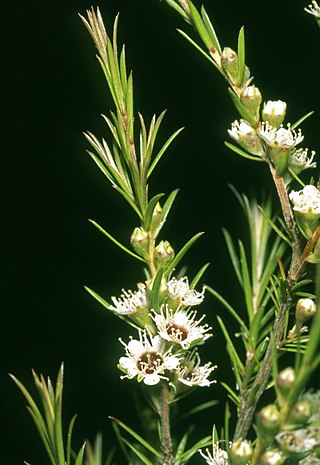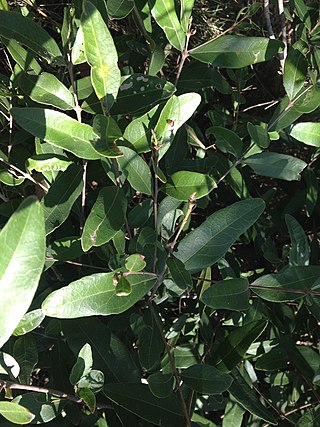
Notelaea is a genus of Australian plants in the olive family. They are commonly known as 'mock-olives'. Twelve species are currently recognized.

Baccharis linearis, the romerillo or Chilean little rosemary, is a common shrub in Central Chile. It is frequently found in old field after agriculture. Cecidia or galls caused by the fruit fly Rachiptera limbata grow as white, spongy and globose tissues on the twigs of the plant.

Hovea linearis is a species of flowering plant in the family Fabaceae and is endemic to eastern Australia. It is an erect or trailing subshrub with mostly narrowly linear to linear leaves with stipules at the base, and mauve and yellowish-green, pea-like flowers.

Petrophile linearis, commonly known as pixie mops, is a species of flowering plant in the family Proteaceae and is endemic to southwestern Western Australia. It is a shrub with narrow egg-shaped leaves, the narrower end towards the base, and oval to spherical heads of hairy, greyish-pink or mauve to almost white flowers.

Drosera linearis, commonly called the slenderleaf sundew, is a sundew found in the Great Lakes region of North America, in Canada and the United States, such as Michigan, and in Montana. It is usually no more than four inches tall.

Notelaea venosa is a very common shrub or small tree in eastern Australia. Occurring in or adjacent to rainforest from Lakes Entrance, Victoria to Cunninghams Gap in south eastern Queensland. Common names include veined mock-olive, smooth mock-olive, large-leaved mock-olive and large mock-olive. Often seen in the bushland areas in Sydney.

Notelaea longifolia is a very common shrub or small tree in eastern Australia. Occurring in or adjacent to rainforest from Mimosa Rocks National Park to Bamaga in far north Queensland. Common names include large mock-olive or long-leaved-olive. An attractive ornamental plant.

Persoonia linearis, commonly known as the narrow-leaved geebung, is a shrub native to New South Wales and Victoria in eastern Australia. It reaches 3 m (9.8 ft), or occasionally 5 m (16 ft), in height and has thick, dark grey papery bark. The leaves are, as the species name suggests, more or less linear in shape, and are up to 9 cm (3.5 in) long, and 0.1 to 0.7 cm wide. The small yellow flowers appear in summer, autumn and early winter, followed by small green fleshy fruit known as drupes. Within the genus Persoonia, it is a member of the Lanceolata group of 58 closely related species. P. linearis interbreeds with several other species where they grow together.

Notelaea ligustrina, known as the privet mock olive, native olive, doral or silkwood, is a plant in the olive family, found in south eastern Australia. It is known to grow in and near rainforests south of Monga National Park in New South Wales, and into Victoria and the island state of Tasmania. The specific epithet ligustrina refers to the Privet, which it resembles.

Prostanthera linearis, commonly known as narrow-leaved mint-bush is a species of flowering plant in the family Lamiaceae and is endemic to eastern Australia. It is an erect, faintly aromatic shrub with glabrous, narrow egg-shaped to linear leaves and white flowers that are often tinged with pinkish-mauve.

Persoonia chamaepeuce, commonly known as the dwarf geebung or heathy geebung, is a plant in the family Proteaceae and is endemic to south-eastern Australia. It is a prostrate shrub with crowded, linear leaves and yellow flowers in the leaf axils.

Kunzea linearis, also known by the Maori name rawiri manuka, is a flowering plant in the myrtle family, Myrtaceae and is endemic to New Zealand. It is a densely-foliaged shrub or small tree, characterised by very narrow leaves and clusters of small white flowers with five petals and a large number of stamens, which are longer than the petals. It grows in the north of the North Island and is the most distinctive of the New Zealand kunzeas.

Cheiranthera linearis, commonly known as finger-flower, is a flowering plant in the family Pittosporaceae. It is a small shrub with deep purple flowers, yellow stamens and dull green linear shaped leaves. It is found growing in New South Wales, Victoria and Queensland.

Rhadinothamnus rudis is a small shrub with needle-shaped, angular branchlets and single white flowers at the end of branches. This species and the three subspecies are endemic to Western Australia.

Hibbertia linearis is a species of flowering plant in the family Dilleniaceae and is endemic to eastern Australia. It is a shrub with linear to oblong or egg-shaped leaves and yellow flowers with 15 to 25 stamens arranged around the three carpels.
Tylophora linearis is a species of plant in the dogbane family that is endemic to Australia.
Pandorea linearis is a species of flowering plant in the family Bignoniaceae and is endemic to Queensland. It is similar to Pandorea pandorana but has nine to thirteen linear leaflets, the lateral leaflets 11–42 mm (0.43–1.65 in) long and 1.5–6 mm (0.059–0.236 in) wide.

Notelaea ipsviciensis, also known as the Cooneana Olive, is a species of flowering plant in the olive family that is endemic to Australia.

Notelaea johnsonii, also known as the veinless mock olive, is a species of flowering plant in the olive family that is endemic to Australia.
Notelaea neglecta is a species of flowering plant in the olive family that is endemic to Australia.

















